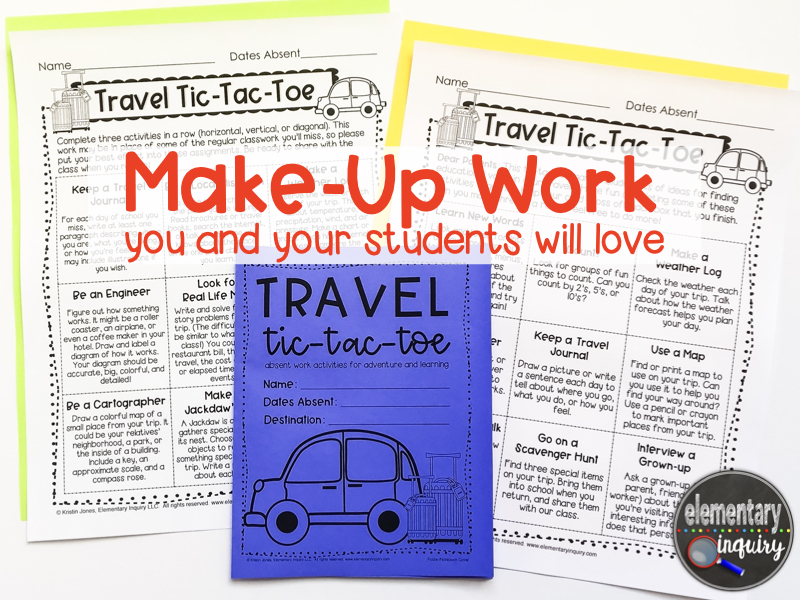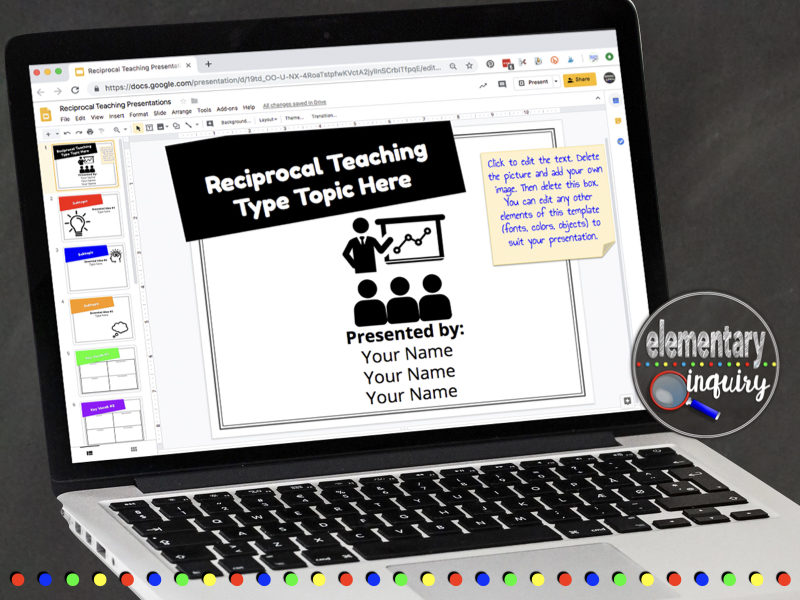Make up assignments: ugh! I hated it as a student, and I think I’m even less fond of it as a teacher.
When students miss several days of school for a trip, make up work is stressful for everyone involved. It means extra books and materials for families to lug around and time spent on school work rather than planned trip activities. It can be frustrating for parents if instructions are unclear, and it’s frustrating for teachers to gather materials ahead of time and still need to spend time helping students catch up when they return.
Early in my teaching career, I decided I wanted to create a better option for make up work that would be less painful for all involved. I wanted to have a go-to stash of prepared, valuable learning activities to send with students who were traveling and requested make-up work ahead of time.
That’s why I created Travel Tic-Tac-Toe bags. Each bag contains a tic-tac-toe gameboard along with all of the basic supplies that students will need. The gameboard contains nine content-based student choice activities for make up assignments, like keeping a journal and making a travel budget, that integrate academic skills with vacation activities. My goal was to help students and their families make the most of the educational value of traveling so that they can enjoy their vacation without the added stress of unrelated makeup work.

My students and their families have loved completing many of the Travel Tic-Tac-Toe activities in lieu of traditional makeup work, and I have loved how easy the prep work is! Here are several reasons why Travel Tic-Tac-Toe works as an alternative to a long list of makeup work:
- It gives students choices of what activities to complete. We know that students learn best when they have some say in how they are learning and how they demonstrate their learning. The activities on this board are arranged so that I can tell students to pick any three tasks in a row, and they will have a variety of literacy, math, and cross-content work.
- There’s no way to replace classroom learning experiences, discussions, and teacher directions. If your classroom thrives on hands-on, cooperative learning activities, there’s just no way to replace that for absent students. Many of the worksheets I use or the assignments I give just wouldn’t make sense without the classroom experience. That’s why I decided to embrace the different learning opportunities that students will have while traveling. Then, I do my best to catch the student up on as much as I can once they return to school without assigning additional homework.
- These activities encourage applied, relevant learning. In contrast to the statement above, the Travel Tic-Tac-Toe activities are designed to enhance the experiences students have on many kinds of trips. They can easily be completed in the car, in a hotel, and during downtime without requiring any extra books or materials from school.
- It’s less work for everyone. I don’t have to stress about gathering work ahead of time, and I only save the most vital papers for students to review when they return. Students and parents appreciate not having to lug heavy textbooks around and often say that they enjoyed completing the tic-tac-toe activities as a family rather than needing to make time for regular homework.

If you’d like to try Travel Tic-Tac-Toe, sign up here to receive access to an editable Google Slides file! Here are some tips for using Travel Tic-Tac-Toe with your students:
- Make several Travel Tic-Tac-Toe bags at the beginning of the year. Include all supplies students might need, like different kinds of paper, regular and colored pencils and a pencil sharpener (markers run out and crayons melt), and a clipboard or folder.
- Include a note explaining your expectations and student choice. I usually ask students to complete any three activities in a row. That feels about right for trips that last from a few days to a week. If the student is gone longer that a week, you might ask him to complete more than three tasks.
- Emphasize your understanding that families will need to prioritize travel activities and school work differently. I always give families the choice of how much to complete, if any at all. Some families don’t want to keep up with any work while traveling, in which case I encourage them to just keep up with reading or enjoy an audiobook as a family. If students or their parents don’t want to complete these tasks or feel that they’re not a good fit for their trip, I explain that I’ll keep a detailed list of traditional make up work that will be waiting for the student when she returns.
- Be flexible with grading. The point of Travel Tic-Tac-Toe is to replace and simplify make up assignments. Find as many ways as possible to justify replacing missed work with the activities from Travel Tic-Tac-Toe. Perhaps you can replace an in-class writing assignment grade with students’ travel journals, or maybe you have enough math quizzes already that you don’t need the student to make up the one she missed (try giving her the option!). Of course there are standards we must meet with our students, but be selective in what work you require students to complete when they return. Save a small pile of only the most important class assignments and notes they missed.
- Give students the opportunity to share with the class. I’ve had many students enjoy choosing an activity or two to share with the class after they return. The rest of us also enjoy hearing about the student’s adventures. (Also, hello oral presentation grade!)
If you’ve loathed traditional absent work as much as I did, you can get a copy of Travel Tic-Tac-Toe to share with your students by clicking here. I’m only sharing this free editable version with my email community!
I’ve gotten great feedback from other teachers who have used Travel Tic-Tac-Toe, along with several requests for more differentiated and content-area specific options. You can check out the complete pack here to see gameboards specific to ELA and math/science, gameboards with additional activities for multiple or longer trips, and coordinating student materials that are ready to print and go. All of these resources are completely editable, too!


I’ve teamed up this month with several other upper elementary bloggers to talk about ideas for helping students and teachers learn to love tricky topics and assignments. Check out their posts below!

Spark a Love of Learning with Games | The Owl Teacher
Spark a Love of Social Studies | Tried and True Teaching Tools
3 Ways to Inspire a Love of Fractions | Mix and Math
Just-Right Reading: I Love Myself! | Reading by Heart
5 Ways to Ignite a Love of Math Problem Solving | Think Grow Giggle
Loving to Write Informational Texts | Mikey D Teach
Valuing Student Voice to Create a Love of Learning | Wild Child’s Mossy Oak Musings
Developing Grit: Learning to Love a Challenge | Kerry Tracy
How to Build a Love of Geometry | Love Learning






